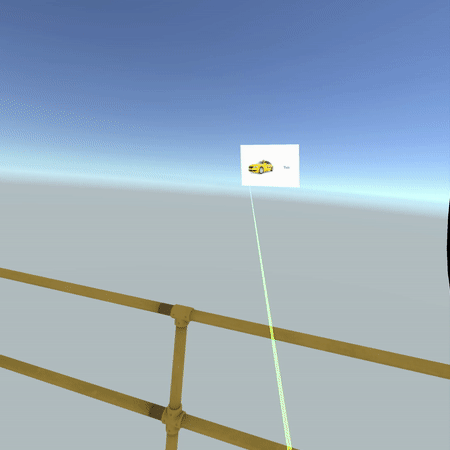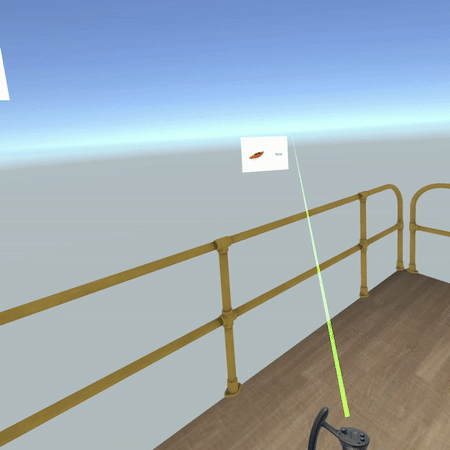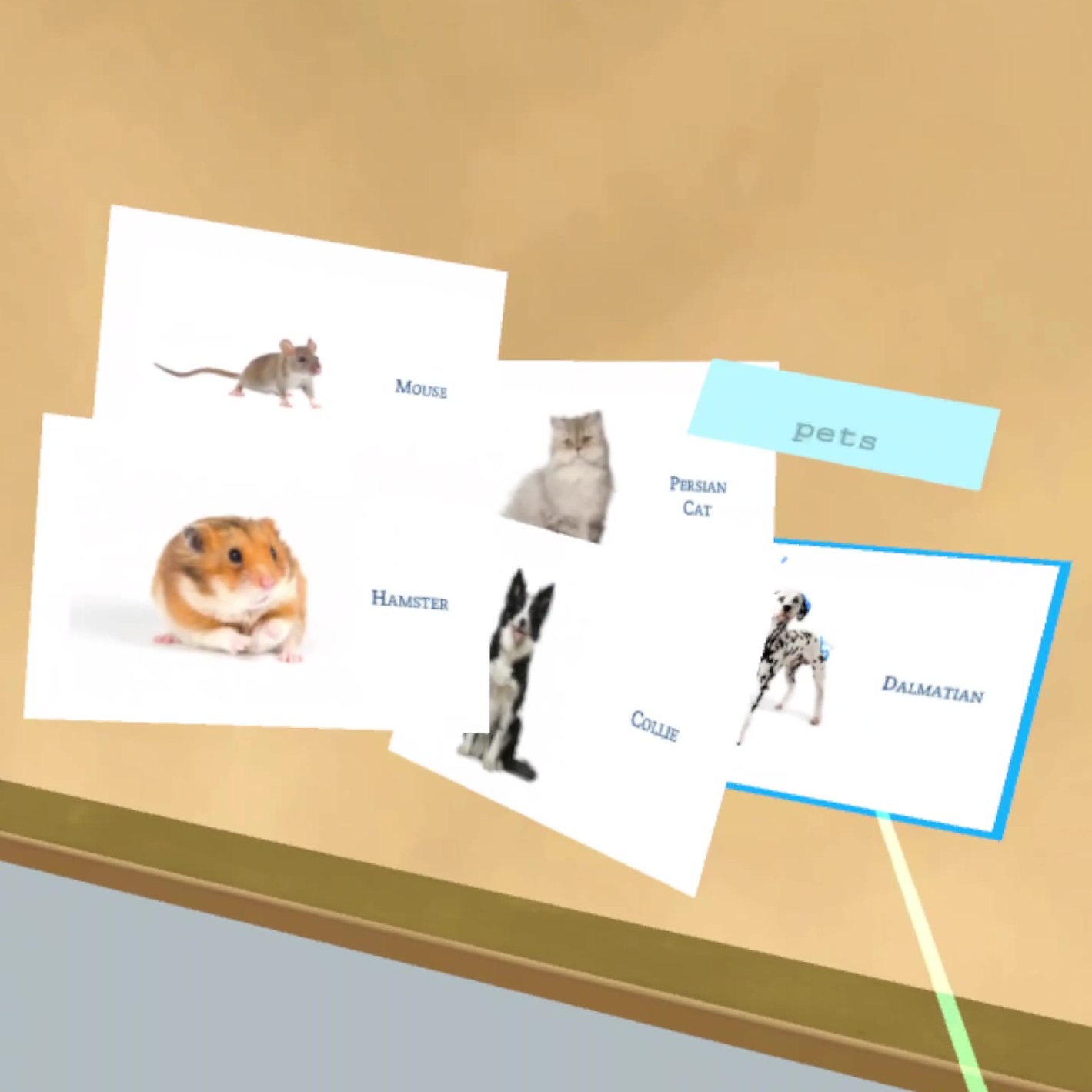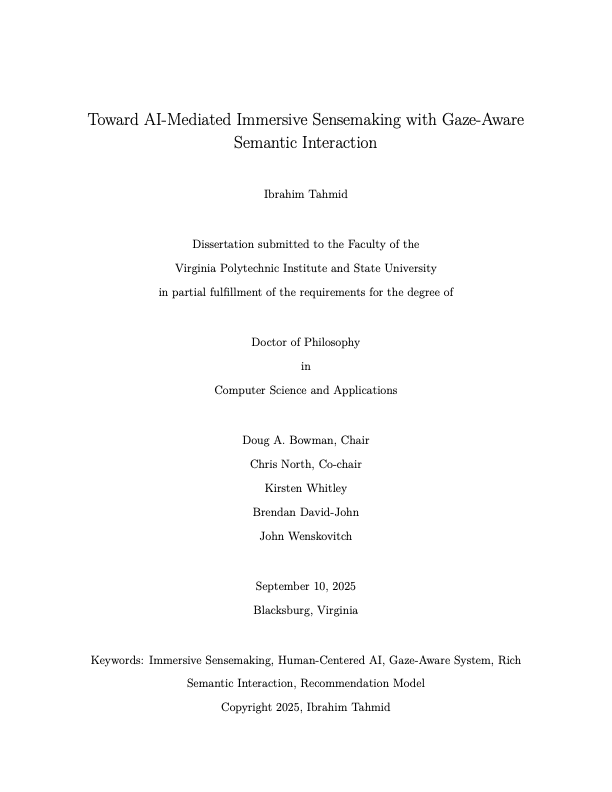Case Study: Gaze Aware AI for Immersive Analytics
Published:
Audience: UX Designer & UX Researcher recruiters.
My role: End-to-end research + prototyping in MR; eye-tracking–driven AI cues; multi-study validation.
Problem
Sensemaking across many interconnected documents overwhelms users’ working memory.
Solution
Mixed Reality workspace + gaze-aware AI cues to guide foraging and synthesis.
Evidence
5 studies (N=115); alignment between self-reported relevance and GazeScore; lower workload signals.
Introduction
When users must browse large amounts of interconnected information, the process can be mentally exhausting. This project investigates how Mixed Reality (MR) and Artificial Intelligence (AI) can reduce that demand by guiding attention and supporting synthesis.
Cross-functional Partners
- Principal Investigator (PI) — 3D Interaction & User Experience
- Co-PI — Visualization & Semantic Interaction
- Industry Sponsor — Consumer (Analyst) Behavior Analysis
- Consultants — Eye Tracking; Human–AI Collaboration
- Consumers/Analysts — Feedback on demo
My Role
Lead Researcher
- Surveyed prior work, defined the research pathway, implemented MR applications, and ran the studies.
- N=115 across 5 studies in room-scale MR; 60–120 min sessions; quantitative + qualitative analysis.
- Weekly stakeholder readouts; translated findings into design guidelines.
Research Question
Primary RQ: How can we alleviate cognitive load during sensemaking tasks?
Approach: Identify the Problems
Resources Available
- 100+ hours of videos: people solving complex sensemaking tasks in MR.
- 30+ papers across small 2D, large 2D, and immersive 3D displays.
- Weekly stakeholder check-ins to validate interpretations.
Outcome (Key Problems)
- Not enough space for data. Users struggle to arrange and revisit large information sets.
- Exhaustive browsing. Users juggle too much in working memory while searching for new, related items.
Solution Proposal
- Not enough space? Use a 3D environment to show the dataset at once, leveraging spatial memory and embodied interaction.
- Overloaded mind? Train an AI that monitors gaze to anticipate perceived relevance and provide personalized visual cues to browse more efficiently.
Study 1: Validating Human–AI Collaboration
RQ: Can AI alleviate user load by automating parts of the sensemaking process?
Experiment Design
- Participants: Within-subjects (N=27)
- Task: Organize flash cards into meaningful clusters
- Conditions:
- Semi-automated clustering: AI clusters nearby cards
- User-controlled clustering: User creates clusters manually
- Control: No explicit clusters
- User Experience: Virtual room with a passthrough portal to keyboard; controller interaction; Varjo XR-3 (tethered)
- Data: NASA-TLX, SUS, UEQ, semi-structured interview, interaction logs
Proximity
Semi-Automated Clustering
Overlap
User Controlled Clustering
Freestyle
No Explicit Clustering
Key Findings
Users preferred the semi-automated approach for ease, comfort, and performance.
Users wanted rationales to avoid feeling a loss of control when AI acted.
Study 2: Turning Gaze into Intent
RQ: How do we convert raw gaze into a reliable predictor of user intent during sensemaking?
Key Challenge: In multi-document sensemaking, simple metrics (fixation time/count) suffer frequency and length biases. We introduced GazeScore to address these biases and tested its feasibility.
Experiment Design
- Participants: N=12
- Task: Solve a sensemaking puzzle with two entwined plots
- User Experience: Virtual documents/notes/labels overlaid on the real world; hand gestures; HoloLens 2 with eye tracking
- Data: NASA-TLX, self-reported topic relevance, interviews, interaction + eye-tracking logs
Key Findings
Self-reported relevance aligned strongly with GazeScore-suggested topic relevance.
Participants wanted GazeScore-derived suggestions integrated into their workflow.
Design Approach
It’s not enough to predict perception; the system must communicate relevance via intuitive visual cues while preserving task flow.
Cue goals
- Detect relevant information
- Quantify relevance
- Maintain readability (relevant & irrelevant)
- Preserve spatial relations
Cues tested
- Size (more relevant → larger)
- Background color (more relevant → darker)
- Border color (more relevant → darker)
- Orientation (less relevant → tilt)
- Animation (bring relevant closer)
- Depth (push less relevant farther)
| Size | Background Color | Border Color | Orientation | Animation | Depth | |
|---|---|---|---|---|---|---|
| Detect Relevant Documents | ✓ Yes | ✓ Yes | ~ Depends (thickness) | ✓ Yes | ✓ Yes | ✓ Yes |
| Quantify Relevance | ✓ Yes | ✓ Yes | ✗ No | ✗ No | ✗ No | ✓ Yes |
| Readability (Relevant) | ✓ Yes | ~ Depends (contrast) | ✓ Yes | ✓ Yes | ✗ No | ✓ Yes |
| Readability (Irrelevant) | ✗ No | ✓ Yes | ✓ Yes | ✗ No | ✓ Yes | ✓ Yes |
| Preserve Spatial Relations | ✗ No | ✓ Yes | ✓ Yes | ✗ No | ✓ Yes | ✗ No |
Evaluation of visual cues for representing document relevance.
Decision: We selected background color as the primary relevance cue.
Evaluating GazeScore-Derived Cues
RQ: Can gaze-derived cues help users offload parts of their thought process?
Experiment Design
- Two-part study
- Professional analysts (N=4): Solve the puzzle efficiently (without writing their approach). AI monitors gaze and annotates documents via visual cues.
- Novice analysts (N=40): Follow the professional’s approach guided only by the gaze-derived cues.
- User Experience: Virtual documents/notes/labels overlaid on the real world; 6-DoF controllers; Meta Quest Pro with eye tracking
- Data: NASA-TLX, User Engagement Questionnaire, Trust in AI questionnaire, interviews, interaction + eye-tracking logs
Key Findings
Gaze-aware AI + cues helped novices follow expert approaches.
Gaze-aware cues reduced physical demand.
Final Design Guidelines (Selected)
- Invest in the start. Ensure early exposure to essential information so gaze-aware AI learns from a solid baseline instead of compensating for poor priors.
- Reduce, then enrich. Begin with minimal, global signposts during foraging; progressively layer local, relationship-focused cues as synthesis begins.
- Prioritize trust and clarity. Attach brief explanations to each suggestion (key terms, one-line summary, confidence) so users can judge fit without breaking flow.
- Preserve agency. Offer accept / dismiss / defer / undo; keep spatial stability; change layout only on user request.
- Keep assistance in situ. Use previews, lightweight filters, and context-aware actions near the content to reduce keyboard-based search.
Impact
- Academic: Early evidence for AI-mediated immersive sensemaking using gaze-derived signals.
- Industry: Actionable guidelines for analysts working with high-volume, interconnected data in MR.




